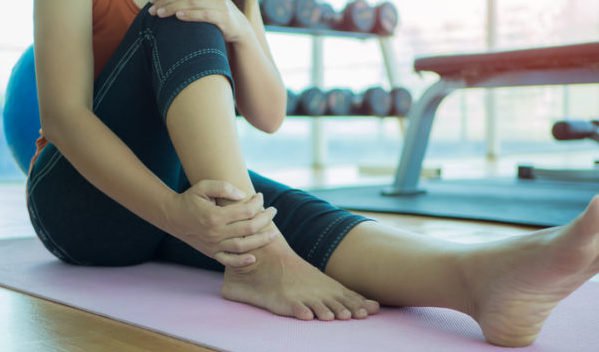Anatomy, Articles, In the Press, Resources, Yoga Medicine® News
Chronic Pain: What Yoga Teachers Should Know

What Yoga Teachers Should Know About Students with Chronic Pain
According to the National Institutes of Health (NIH), approximately 1 in 4 adults in the United States suffers from daily pain. Given this high percentage and that more healthcare providers are recommending yoga for chronic pain, yoga teachers are very likely to find a chronic pain sufferer in their class.
As a physician who specializes in chronic pain management, here are some factors I think yoga teachers should be aware of when teaching students with chronic pain.
Chronic pain is more than a physical diagnosis
The International Association for the Study of Pain (IASP) defines pain as a subjective unpleasant sensory, emotional experience due to an actual, or potential, injury or described in terms of such injury. By definition, the medical community recognizes that pain has a mind-body connection and can only be described subjectively. Unlike diabetes or hypertension, there are no objective measurements to diagnose chronic pain. As they say, “Pain is in the brain,” however, this does not mean that pain has no physical effects on the human body. People in chronic pain have sustained deep myofascial tension and psychological stress, especially of the postural groups of muscles. Thus, patients in pain often have poor posture which further contributes to pain. Chronic pain affects breathing as well. Respirations become mainly thoracic with a lesser excursion of the diaphragm into the abdomen leading to fast, shallow breathing.
There are emotional effects
Chronic pain sufferers have decreased daily function and increased chances for anxiety and depression. The body is placed in a state of perpetual stress (via the hypothalamic-pituitary-axis) and thus in a state of hyperarousal. In other words, your students may feel emotionally drained and/or have emotions stored in various parts of the body. Because of this, they may find it very difficult to relax.
It is common for chronic pain sufferers to consciously or subconsciously seek to escape their pain through avoidance, medications, etc. However, research has shown that the opposite is beneficial: mindfulness and body awareness.
Yoga has been long proven to provide benefit for chronic pain sufferers both physically and emotionally. Yoga teaches pain sufferers to activate the relaxation response which lowers inflammation and stress leading to less pain and suffering.
In one randomized controlled trial, a specific form of yoga, called Yoga of Awareness, a type of mindfulness-based yoga therapy compared 53 fibromyalgia patients with standard care. Those receiving the yoga program demonstrated greater improvements in pain, fatigue, and mood and in pain catastrophizing, acceptance, and other coping strategies. [1]
Yoga teachers should also realize that some students with chronic pain may never have their pain resolved. However working in combination with the student’s physician, chronic pain can be managed like any other chronic illness.
Specific precautions for common chronic pain conditions:
Back Pain:
This is the most common pain complaint healthcare providers see. Back pain is often due to poor posture, misalignment, and/or degeneration of the spine. As a yoga teacher, be on the lookout for red flags including decreased strength or sensation in the arms/legs, shooting pain down one arm/leg or another, or loss of control of the bowel or bladder. If these signs and symptoms are present, the student should immediately contact their medical provider.
Myofascial Pain (Fibromyalgia):
This condition is primarily caused by prolonged inflammation and a chronic stressful mindset and is frequently associated with emotional pain, depression and/or anxiety. People with fibromyalgia will have diffuse full body pain with particularly painful trigger points. They may require gentle and slower movements.
Migraines:
Most migraine sufferers know what works for them and what triggers their headaches. Be careful with any movements they know will trigger them such as inversions. Red flags include impaired vision, dizziness, lightheadedness, or imbalance.
Knee/Hip/Shoulder (joint) pain:
Chronic joint pain is typically caused by osteoarthritis or inflammation and degeneration of the joints leading to stiffness and pain. These students will need gentle work around the muscles and tendons that surround the involved joint. Avoid deep flexion or hyperextension of the affected joints. Red flags include swelling and redness of the joint.
Neuropathic Pain:
This condition is caused by nerve damage affecting the smallest nerve endings in the skin, most typically in the hands and feet. It can affect a person’s sensation and balance. Because of this, be careful with balancing poses or if you ask the student to close their eyes. These students will be more likely to lose their balance with eyes closed.
Cancer Pain:
Students with cancer-related pain will differ immensely depending on the location of cancer, stage of treatment, history of surgical operations and more. Students with cancer will have emotional pain as well. If they are on or have had chemotherapy, students may have fragile bones susceptible to fractures and/or easy bruising.
Be careful to avoid falling and deep twists or bends. They would benefit most from gentle and restorative yoga practices, meditation, and pranayama which can soothe the body’s inflammatory responses.
A note on pain medications:
For students who take prescription opioid pain medications, you will need to take extra precautions. Opioids may make it difficult for students to exercise safely because these medications affect the cardiovascular and respiratory systems. The heart rate and respirations are typically slowed and become less responsive to increased exertion, thus increasing the likelihood of lightheadedness and shortness of breath. Chronic opioid users may also experience changes in hormonal regulation leading to decreased sex hormones, decreased immunity, changes in mood, and increased likelihood for osteoporosis. They may also experience chronic constipation and nausea. For these students, gentle practice is preferable with reduced exertion.
As always, have your student consult their medical provider before beginning or resuming any physical program.
Sources
1. Carson, JW. A pilot randomized controlled trial of the Yoga of Awareness program in the management of fibromyalgia. Pain. 2010 Nov;151(2):530-9.












